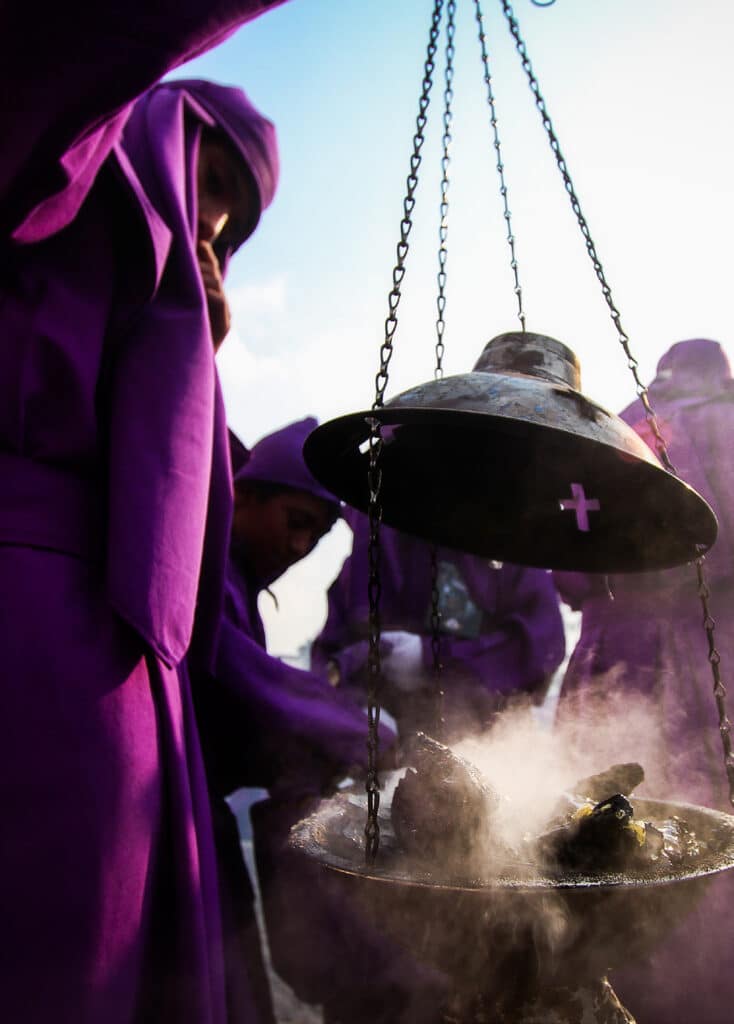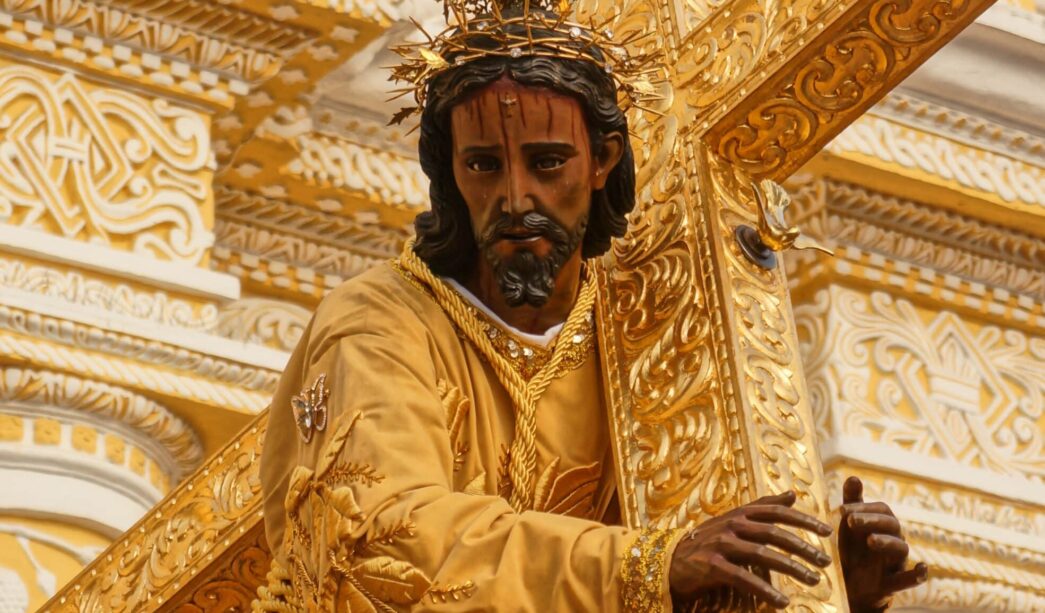This article first appeared in Our Sunday Visitor magazine. Subscribe to receive the monthly magazine here.
The city of Antigua lies nestled in the highlands of southwestern Guatemala. I visit at least once a year, and the magic and beauty of the place never fail to take my breath away. In the mornings, I take my cup of local coffee onto the rooftop garden to watch the sun rise and the fog peel away. The air is cool and smells of jasmine and pine; street dogs play in the courtyard below me, and the volcano puffs away quietly in the distance as if it means no harm.
There is little need for memento mori prayers when you live in an active tectonic zone. Antigua is surrounded by three volcanoes — Acatenango, Volcán de Agua, and Volcán de Fuego, the last of which is still active, constantly releasing clouds of ash. As you sip wine on a charming terrace or watch girls bounce down the streets in their quinceañera gowns, the volcano spits its dark clouds into the sky, and you can’t help but feel how beautiful and fleeting it all is.

The city has a European, old-town feel with its cobblestone streets, Baroque-influenced architecture and Renaissance grid plan, but it is also distinctly Latin American with its brightly colored homes, hidden courtyard patios and busy markets. Designated a UNESCO World Heritage Site in 1979, Antigua is a hub for local, artisanal food and textiles. Shops are stocked with local honey, coffee, teas, chocolate, vanilla, cardamom, turmeric and other spices. Loom-woven and hand-embroidered textiles are worn by local women selling traditionally made hammocks, tablecloths, clothing and bags. The city teems with abundance: Flowered trees spill over walls and out of windows onto the streets, and everywhere you turn there are hidden alleys and back rooms to be explored.
Between volcanic eruptions and earthquakes, Antigua has been demolished and rebuilt many times, changing repeatedly throughout history. Situated on the Ring of Fire and sandwiched between two oceans, it is exposed to tropical storms, hurricanes, mudslides, earthquakes and volcanic eruptions. It has suffered a long series of city-shattering disasters, including 8.3- and 7.5-magnitude earthquakes in 1942 and 1976, damage from hurricanes Mitch and Stan in 1998 and 2005, and a volcanic eruption in 2018. Even today, while walking through the city, you might stub your toe against a piece of rubble from a crumbled church or a sizable crack in the sidewalk.

One of Antigua’s greatest attractions is the ruins of the old San José Cathedral. This magnificent Baroque church was built in 1545 but was nearly demolished in the earthquake of 1773. What stands today is a series of ruined columns, arches and walls. Whispers echo in the alcoves, and rubble is piled in the empty side chapels. The roof is missing, leaving what remains completely open to the sky, and dozens of pigeons nest in the nooks where bricks have fallen.
Every building bears witness to the history of the city. Antigua is no stranger to suffering and perseverance, and its inhabitants carry an acute awareness of living in an ephemeral world, buoyed by the hope of eternal life.
Semana Santa
Antigua is a city where the differences meet: The modern world encroaches on the old, traditional Indigenous crafts complement colonial Spanish architecture, and brightly painted homes stand alongside sun-bleached ruins.
Much of Antigua’s local art, architecture, food and customs have emerged from the city’s long history of diversity. It is a place where Mesoamerican, European, African and Hispanic peoples have come together to form unique traditions, and these are prominently on display during Lent each year. Many of the decorations, processions and festivals in Antigua developed over time as colonial Spanish Catholicism mixed with ancient Mesoamerican traditions and practices.

The result is a Holy Week (Semana Santa) unlike anything else throughout the rest of the world. More than 1 million visitors travel to Antigua each year to witness the festivities, a unique blend of Catholic faith, the native traditions of Mesoamerica and modern Guatemalan culture.
Alfombras
One of the most notable Holy Week traditions in Antigua is the creation of alfombras, large carpets constructed in the streets in anticipation of each procession. They are handmade using flowers, colored sawdust, pine needles, grasses, and even fruits and vegetables.

Each alfombra is uniquely designed by members of the community and can take months to plan. They display colorful patterns, often including traditional Mayan motifs seen on Indigenous textiles, as well as animals, flowers, and religious symbols such as crosses, doves and sacred hearts.
Using wooden slats and large stencils, teams of locals work on the carpets, attracting crowds of pilgrims and tourists. Members of the community help with the project, slowly layering different colors and patterns on top of one another to achieve desired effects.

The alfombras are long and thin, designed to cover extended strips in the center of the road, allowing the crowds to gather around them for the procession without ruining the art. The most important rule is that no one is allowed to step on the alfombras until the processions come through the streets, when the men carrying the floats will walk across the intricate artworks, stirring up the dust, and leaving little of the original beauty behind.
Andas
Antigua is literally a city risen from the ashes. Destroyed several times, it has not wavered in its devotion to God. As Holy Week nears, the alfombras are surrounded by pilgrims waiting to see the processions. Once the artists place their finishing touches, the streets will fill with clouds of incense burned by priests, the first to process through them. The ephemeral carpets will be stirred up into the air as hundreds of men tread solemnly across them carrying huge floats on their shoulders.
The floats, called andas, are the salient features of Antigua’s Holy Week processions. The andas are like mobile altars supporting statues of Christ, the Virgin Mary and other important religious scenes and figures as they are carried through the streets.

Kicking the sawdust into the air, costumed men shoulder the biggest andas, the ones bearing scenes of Christ’s passion. Many of these men walk with their heads pressed against each other or the wood to hold the immense weight; their eyes are closed or turned toward the sky, unable to see the street ahead. The altar they carry on their backs was carried by their fathers, grandfathers and great-grandfathers. It will be carried by their sons for generations to come.
As the men walk with Christ in his passion, the streets become engulfed in incense, dust, mourning songs, ringing bells, traditional and colonial instruments, and the murmur of the crowds.
Good Friday
The processions on Good Friday are by far the most intense, lasting around 12 hours. As the clock strikes midnight, people begin to trickle onto the streets. At 3 a.m., men on horseback dressed as Romans burst through the doors of the Iglesia de la Merced and enter the public square. They read aloud the alleged transgressions of Christ before pronouncing his sentence: crucifixion.
Then, the city’s largest anda, weighing nearly 7,000 pounds, emerges from within the church, carried by hundreds of men. The anda bears a statue of Christ bent beneath the weight of the cross. The procession is led by the Roman soldiers, followed by Pharisees, Sadducees and the criminals who were crucified with Christ. This begins the reenactment of the Way of the Cross. As Christ carried the cross toward Calvary, the men — surrounded by women and children — carry the altar throughout the streets of Antigua for all to see.

The men carrying the anda — called w — are dressed in a royal, Lenten purple, symbolizing both Christ’s royalty and the suffering of his passion. Carrying the anda in elaborate costumes through the heat of the day is no easy feat, and it sways slowly and dramatically through the crowd. The men struggle as they inch down the road, leaving their post after a block or two so other men can bear the weight for a time. The parallels to Christ carrying the cross, though in a sense incomparable, are striking.
Perhaps the most striking participant, however, is the lone individual who guides the anda from the front. With his back to the wood, he holds the two front posts with his arms outstretched in a position reminiscent of Christ’s hands nailed to the cross. The man simultaneously leads the statue of Christ on the cross through the crowd and foreshadows the moment that will come at the end of the road.
To attend the procession is to be tossed in a sea of people. The floats seem to sway on the swell of the crowd. Hundreds of thousands of men, women and children from around the world kneel, cry, pray, shout praises and take photos as the anda passes. And though the cucuruchos stand out in their vivid purple uniforms, the streets are so densely packed with people that, from above, the anda appears to be shouldered by the entire mass of the faithful. Even as a viewer, you are swept up by the clouds of incense and the crowd, and cannot help but feel the immediacy and severity of the procession.

Men at the back push the anda forward and hold it as steady as they can. An orchestra follows on foot, playing triumphal music throughout the streets. A second anda follows, much smaller, shouldered by women, with a statue of the Virgin Mary. Mary is surrounded by symbols of the Annunciation and Nativity, including the angel Gabriel, the star of Bethlehem and hundreds of white lilies.
Holy Saturday
The Good Friday anda dedicated to the Virgin foreshadows the procession on Holy Saturday, which is much smaller and quieter than those of Good Friday, but no less moving. After Christ’s crucifixion, viewers and participants in the processions are clothed in black. The floats on Holy Saturday bear statues of the grieving Virgin, carried exclusively by the women of the town. The women wear black dresses and dark veils over their hair in mourning with the Virgin. Children accompany their mothers, holding onto their clothes and hands as they walk through the streets. It is a dark and solemn day, and the crowds are quiet and tearful. The evening is still, as the town awaits the coming celebration of Christ’s resurrection.

Easter Sunday
As the fog peels away on Sunday morning, the light breaks through the trees. The long wait has passed, the period of mourning is over, and the day of celebration has arrived. The colors of Antigua seem brighter than ever, and the streets are filled with warm greetings, tears of joy and children running around with bubbles and paper windmills.
The final processions include statues of Christ rising from the dead, haloed and wearing a victorious red-and-white gown. The Resurrection anda, decorated with hundreds of fresh flowers, restores the city to its state of abundance. Shops open their doors, foods from around the country are prepared on every corner, and the city’s Central Park is once again filled with vendors, children, tourists, families and dogs enjoying the beauty of the day. Fireworks are set off in the streets all day and night, and friends and family celebrate by sharing Easter meals.

As Semana Santa draws to a close, Antigua slowly returns to its usual rhythms. Pigeons nest in the ruins of San José Cathedral, and the Volcán de Fuego carries on quietly in the distance, releasing smoke and ash into the air.








